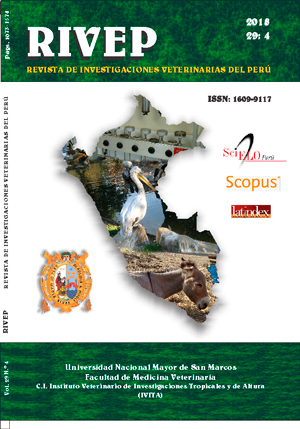Characterization of genetic nuclei of the alpaca production systems of the central highlands of Peru
DOI:
https://doi.org/10.15381/rivep.v29i4.15182Keywords:
production systems, breeding alpaca, genetics nucleus, alpaca, siresAbstract
This study aimed to characterize the genetics nucleus of three alpaca production systems in the central highlands: community enterprises and cooperatives (CEC), communal farms (CF) and livestock associations (LA). The study was conducted in the period 2006 to 2008 and included the static diagnostic of 28 alpaca herds; evaluation of 30 community genetics nucleus and estimation of the production parameters of a central nucleus of alpaca breeders (ABCN) composed of the best alpacas of 22 livestock units. The results were: a) Static Diagnostic. The CEC exhibited better indicators that other production systems, fibre management and production (CEC 5.2, CF 4.9, LA 5.0 lb/alpaca), grassland area dedicated for alpaca breeding (CEC 3225, CF 1024, LA 195 ha), access to market (CEC national, CF and LA local) and registered animals (CEC 10.5, CF 0.9, LA 0%). b) Evaluation of the genetic nucleus. The CEC showed better indicators than other production systems: proportion of Super class dams (CEC 23, CF 5, LA 0%) and Super sires (CEC 86, CF 52, LA 0%), conformation of the animal (CEC good, CF and LA regular), fleece fineness (CEC fine, CF and LA medium to coarse), cultivated grass (CEC 100, CF and LA 0%) and grassland condition (CEC and CF fair, LA poor). c) Production parameter of ABCN. Alpacas from the CEC genetics nucleus showed performance than other production systems: proportion of Super class dams (CEC 13, CF 8, LA 2%), live weight at shearing (CEC 59.3, CF 58.9, LA 53.1 kg), dirty fleece (CEC 2.4, CF 2.2, LA 2.4 kg) and wick length (CEC 8.9, CF 6.9, LA 7.0 cm). The results showed that the ECC had better parameters than the other production systems evaluated in the study.Downloads
Downloads
Published
Issue
Section
License
Copyright (c) 2018 Cecilio Barrantes C., Enrique Flores M., José Ruiz C.

This work is licensed under a Creative Commons Attribution-NonCommercial-ShareAlike 4.0 International License.
AUTHORS RETAIN THEIR RIGHTS:
a. Authors retain their trade mark rights and patent, and also on any process or procedure described in the article.
b. Authors retain their right to share, copy, distribute, perform and publicly communicate their article (eg, to place their article in an institutional repository or publish it in a book), with an acknowledgment of its initial publication in the Revista de Investigaciones Veterinarias del Perú (RIVEP).
c. Authors retain theirs right to make a subsequent publication of their work, to use the article or any part thereof (eg a compilation of his papers, lecture notes, thesis, or a book), always indicating the source of publication (the originator of the work, journal, volume, number and date).










